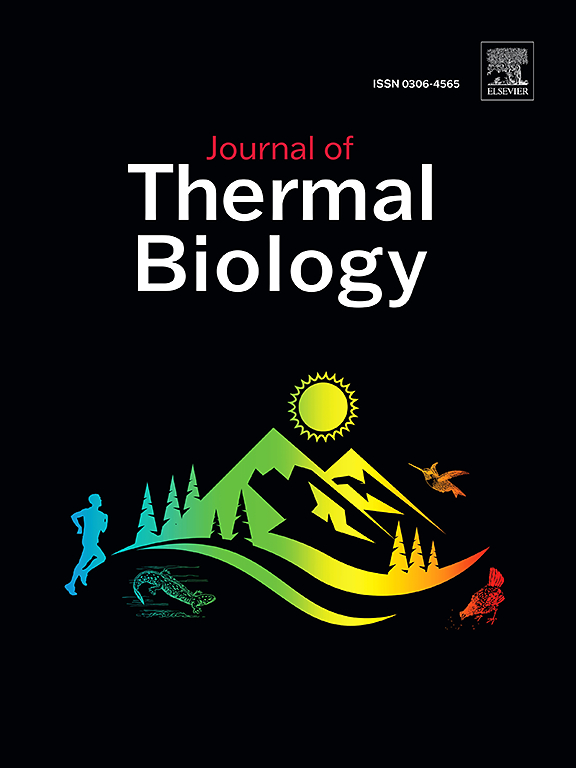The jumping performance of two Eleutherodactylus frog species: the effect of temperature
IF 2.9
2区 生物学
Q2 BIOLOGY
引用次数: 0
Abstract
This study was undertaken to understand the species-specific response and the effect of changes in ambient temperature on the jumping performance of two congeneric tropical frog species, environmental specialist Eleutherodactylus wightmanae and environmental generalist Eleutherodactylus coqui, obtained from three distinct populations across their east-west longitudinal range in Puerto Rico. Three environmental temperatures currently experienced in their natural habitat were selected for treatments: 18 °C, 21 °C, and 24 °C. Jumping performance was determined by the average distance traveled per jump and the average speed per jump based on three consecutive jumps. A significant increase in distance per jump was observed in both species with the temperature treatment of 24 °C, resulting in the longest jump. On average, the specialist Eleutherodactylus wightmanae outperformed the generalist Eleutherodactylus coqui, but the effect was largely affected by temperature treatment and location. At a population level, individuals of both species obtained from the Toro Negro Forest jumped farther than individuals from Maricao and Cayey. Speed per jump was not affected by temperature treatments; instead, differences in speed were observed at the population (i.e. locality) and species level. Individuals of Eleutherodactylus coqui obtained from the Cayey Forest were significantly slower than all other sites in all treatments. In contrast, individuals of Eleutherodactylus wightmanae from the Maricao Forest were slowest in all treatments. The study provides evidence of the species-specific response to increases in temperature and the local adaptation capabilities and thermal plasticity observed across the longitudinal range for two frog species of Puerto Rico. The study also reinstates multifactorial aspects concerning anuran physiology and how biotic conditions affect their performance.
两种棘足蛙跳跃性能:温度的影响
本研究旨在了解两种相同的热带蛙种的物种特异性反应和环境温度变化对两种热带蛙种的跳跃性能的影响,这两种蛙种是环境专家Eleutherodactylus wightmanae和环境通才Eleutherodactylus coqui,它们来自波多黎各东西向纵向范围内的三个不同种群。选择在它们的自然栖息地中目前经历的三种环境温度:18°C、21°C和24°C进行处理。跳跃表现由每次跳跃的平均距离和基于连续三次跳跃的每次跳跃的平均速度决定。在24°C温度处理下,两种植物的跳跃距离均显著增加,且跳跃距离最长。平均而言,特长型怀特曼棘手象的表现优于通才型coqui棘手象,但其效果主要受温度处理和位置的影响。在种群水平上,从托罗内格罗森林获得的两个物种的个体比从马里考和凯伊获得的个体跳得更远。每跳速度不受温度处理的影响;相反,在种群(即地点)和物种水平上观察到速度的差异。在所有处理条件下,Cayey森林的coqui棘手蜥个体的生长速度都明显慢于其他所有地点。与此相反,在所有处理中,Maricao森林的怀马伊蜥(Eleutherodactylus wightmanae)个体最慢。该研究为波多黎各两种蛙类对温度升高的物种特异性反应以及在纵向范围内观察到的局部适应能力和热可塑性提供了证据。该研究还恢复了有关动物生理学的多因素方面以及生物条件如何影响它们的表现。
本文章由计算机程序翻译,如有差异,请以英文原文为准。
求助全文
约1分钟内获得全文
求助全文
来源期刊

Journal of thermal biology
生物-动物学
CiteScore
5.30
自引率
7.40%
发文量
196
审稿时长
14.5 weeks
期刊介绍:
The Journal of Thermal Biology publishes articles that advance our knowledge on the ways and mechanisms through which temperature affects man and animals. This includes studies of their responses to these effects and on the ecological consequences. Directly relevant to this theme are:
• The mechanisms of thermal limitation, heat and cold injury, and the resistance of organisms to extremes of temperature
• The mechanisms involved in acclimation, acclimatization and evolutionary adaptation to temperature
• Mechanisms underlying the patterns of hibernation, torpor, dormancy, aestivation and diapause
• Effects of temperature on reproduction and development, growth, ageing and life-span
• Studies on modelling heat transfer between organisms and their environment
• The contributions of temperature to effects of climate change on animal species and man
• Studies of conservation biology and physiology related to temperature
• Behavioural and physiological regulation of body temperature including its pathophysiology and fever
• Medical applications of hypo- and hyperthermia
Article types:
• Original articles
• Review articles
 求助内容:
求助内容: 应助结果提醒方式:
应助结果提醒方式:


